clock Lancia Ypsilon 2011 Owner handbook (in English)
[x] Cancel search | Manufacturer: LANCIA, Model Year: 2011, Model line: Ypsilon, Model: Lancia Ypsilon 2011Pages: 299, PDF Size: 13.35 MB
Page 16 of 299
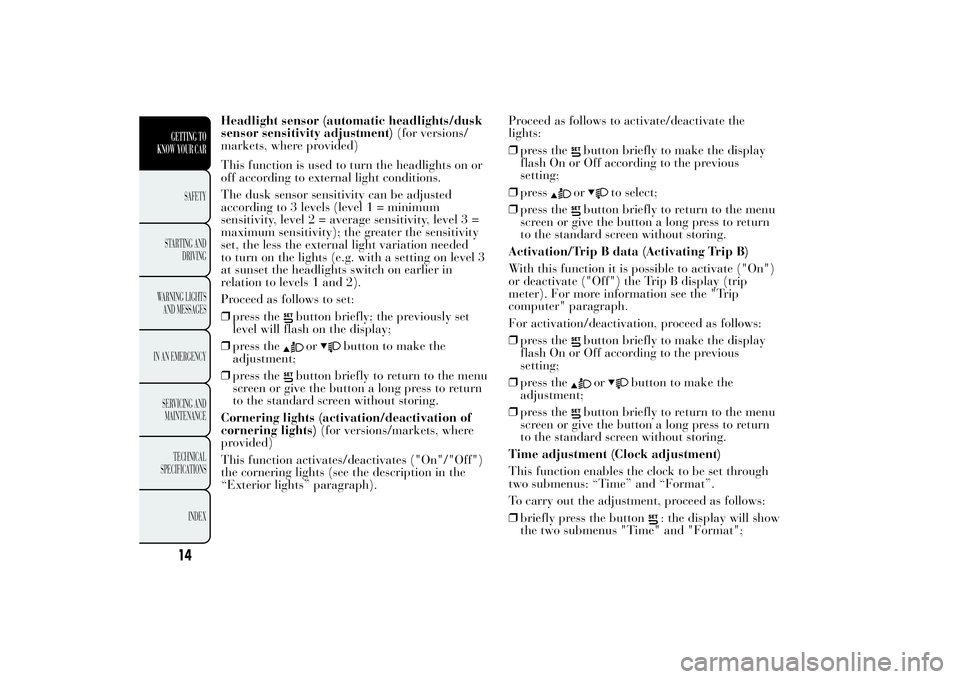
Headlight sensor (automatic headlights/dusk
sensor sensitivity adjustment)(for versions/
markets, where provided)
This function is used to turn the headlights on or
off according to external light conditions.
The dusk sensor sensitivity can be adjusted
according to 3 levels (level 1 = minimum
sensitivity, level 2 = average sensitivity, level 3 =
maximum sensitivity); the greater the sensitivity
set, the less the external light variation needed
to turn on the lights (e.g. with a setting on level 3
at sunset the headlights switch on earlier in
relation to levels 1 and 2).
Proceed as follows to set:
❒press the
button briefly; the previously set
level will flash on the display;
❒press theor
button to make the
adjustment;
❒press the
button briefly to return to the menu
screen or give the button a long press to return
to the standard screen without storing.
Cornering lights (activation/deactivation of
cornering lights)(for versions/markets, where
provided)
This function activates/deactivates ("On"/"Off")
the cornering lights (see the description in the
“Exterior lights” paragraph).Proceed as follows to activate/deactivate the
lights:
❒press the
button briefly to make the display
flash On or Off according to the previous
setting;
❒pressor
to select;
❒press the
button briefly to return to the menu
screen or give the button a long press to return
to the standard screen without storing.
Activation/Trip B data (Activating Trip B)
With this function it is possible to activate ("On")
or deactivate ("Off") the Trip B display (trip
meter). For more information see the "Trip
computer" paragraph.
For activation/deactivation, proceed as follows:
❒press thebutton briefly to make the display
flash On or Off according to the previous
setting;
❒press theor
button to make the
adjustment;
❒press the
button briefly to return to the menu
screen or give the button a long press to return
to the standard screen without storing.
Time adjustment (Clock adjustment)
This function enables the clock to be set through
two submenus: “Time” and “Format”.
To carry out the adjustment, proceed as follows:
❒briefly press the button
: the display will show
the two submenus "Time" and "Format";
14GETTING TO
KNOW YOUR CAR
SAFETY
STARTING
AND
DRIVING
WARNING LIGHTS
AND MESSAGES
IN AN EMERGENCY
SERVICING AND
MAINTENANCE
TECHNICAL
SPECIFICATIONS
INDEX
Page 69 of 299

WARNING
Always use this device when carrying
children. After engaging
the child
lock on both rear doors, check for effective
engagement by trying to open a door with
the internal handle.
PASSENGER SIDE FRONT DOOR AND REAR
DOOR EMERGENCY LOCKING DEVICE
The passenger side front door and the rear doors
have a device to lock them when there is no power.
In this case proceed as follows:
❒engage the metal insert of the ignition key in
position Afig. 54 (passenger side front door)
or B fig. 53 (rear doors);
❒turn the key clockwise and then remove it from
housing A fig. 54 or B fig. 53.The door lock knob can be realigned (only when
the battery charge has been restored) as follows:
❒press the
button on the remote control;
❒press button
for locking/unlocking the doors;
❒open a front door by inserting the key into the
key pawl;
❒operate the internal door handle.
If the child lock was engaged and the
previously described locking
procedure carried out, operating the
internal handle will not open the door but will
only realign the door lock knobs. To open the
door, the outside handle must be used. The
door central locking/unlocking button
is
not disabled by the engagement of the
emergency lock.
IMPORTANT If the battery is disconnected or the
protection fuse blows, the door opening/closing
mechanism must be reinitialised as follows:
❒close all the doors;
❒press button
on the remote control or button
for locking/unlocking the doors on the
instrument panel;
❒press button
on the remote control or button
for locking/unlocking the doors on the
instrument panel.
fig. 54
L0F0215
67GETTING TO
KNOW YOUR CARSAFETY
STARTING
AND
DRIVING
WARNING LIGHTS
AND MESSAGES
IN AN EMERGENCY
SERVICING AND
MAINTENANCE
TECHNICAL
SPECIFICATIONS
INDEX
Page 107 of 299

For diesel engines, use only diesel fuel
for motor vehicles in accordance with
EN590 European specifications. The
use of other products or mixtures may damage
the engine beyond repair and consequently
invalidate the warranty, depending on the
damage caused. If you accidentally refuel with
another type of fuel, do not start the engine,
and drain the fuel tank. If the engine has been
run, even for only a very short time, you will
need to have the entire fuel system emptied in
addition to the tank.
REFUELLING CAPACITY
To fill the tank completely, top up twice after the
pump switches off. Further top-ups could cause
faults in the fuel feeding system.
REFUELLING PROCEDURE FOR VERSIONS
EQUIPPED WITH FUEL TANK PLUG
(for versions/markets, where provided)
Refuel as follows:
❒open the flap A fig. 84 pulling it outwards;
❒keep the plug B still, insert the ignition key in
the lock and turn it anticlockwise;
❒Turn the plug anticlockwise and remove it.The plug has a device C fig. 84 that attaches it to
the flap so that it cannot be lost. When refilling,
attach the plug to the flap, as shown.
After refuelling, fit the plug B fig. 84 (complete
with key) and turn it clockwise until it clicks once
or more. Turn the key clockwise and remove it.
Close the flap A.
The sealing may cause a slight pressure increase in
the tank. A little breathing off, while unscrewing
the plug or introducing the gun in the versions
equipped with "Smart Fuel", is therefore
absolutely normal.
fig. 84
L0F0240
105GETTING TO
KNOW YOUR CARSAFETY
STARTING
AND
DRIVING
WARNING LIGHTS
AND MESSAGES
IN AN EMERGENCY
SERVICING AND
MAINTENANCE
TECHNICAL
SPECIFICATIONS
INDEX
Page 132 of 299
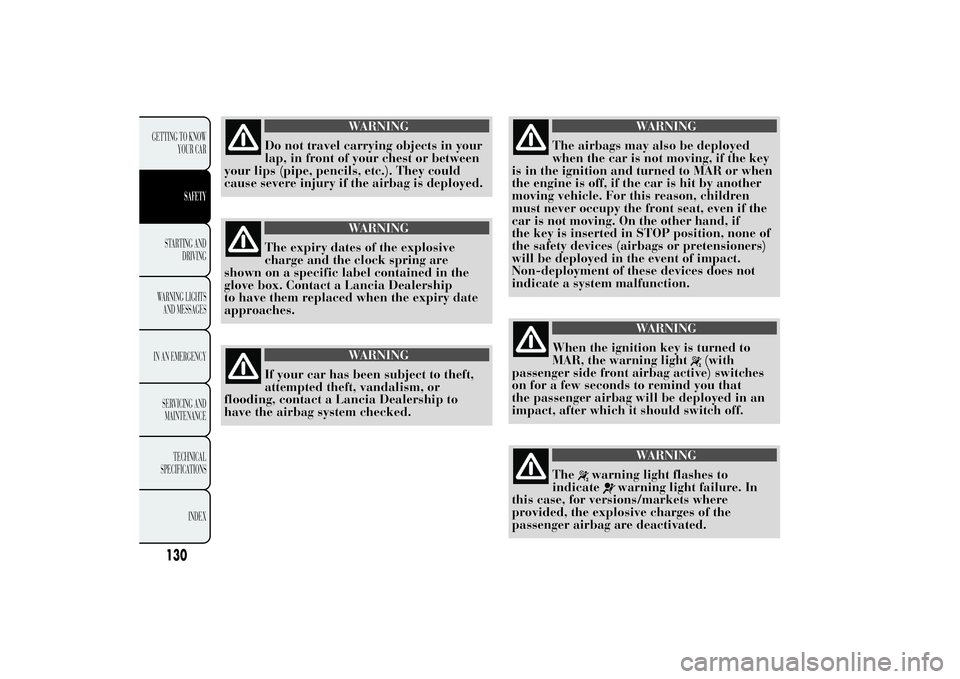
WARNING
Do not travel carrying objects in your
lap, in front
of your chest or between
your lips (pipe, pencils, etc.). They could
cause severe injury if the airbag is deployed.
WARNING
The expiry dates of the explosive
charge and the
clock spring are
shown on a specific label contained in the
glove box. Contact a Lancia Dealership
to have them replaced when the expiry date
approaches.
WARNING
If your car has been subject to theft,
attempted theft, vandalism,
or
flooding, contact a Lancia Dealership to
have the airbag system checked.
WARNING
The airbags may also be deployed
when the car
is not moving, if the key
is in the ignition and turned to MAR or when
the engine is off, if the car is hit by another
moving vehicle. For this reason, children
must never occupy the front seat, even if the
car is not moving. On the other hand, if
the key is inserted in STOP position, none of
the safety devices (airbags or pretensioners)
will be deployed in the event of impact.
Non-deployment of these devices does not
indicate a system malfunction.
WARNING
When the ignition key is turned to
MAR, the warning
light
(with
passenger side front airbag active) switches
on for a few seconds to remind you that
the passenger airbag will be deployed in an
impact, after which it should switch off.
WARNING
The
warning light flashes to
indicate
warning light failure. In
this case, for versions/markets where
provided, the explosive charges of the
passenger airbag are deactivated.
130
GETTING TO KNOW
YOUR CAR
SAFETY
STARTING AND
DRIVING
W
ARNING LIGHTS
ANDMESSAGES
IN AN EMERGENCY
SERVICING AND
MAINTENANCE
TECHNICAL
SPECIFICATIONS
INDEX
Page 169 of 299
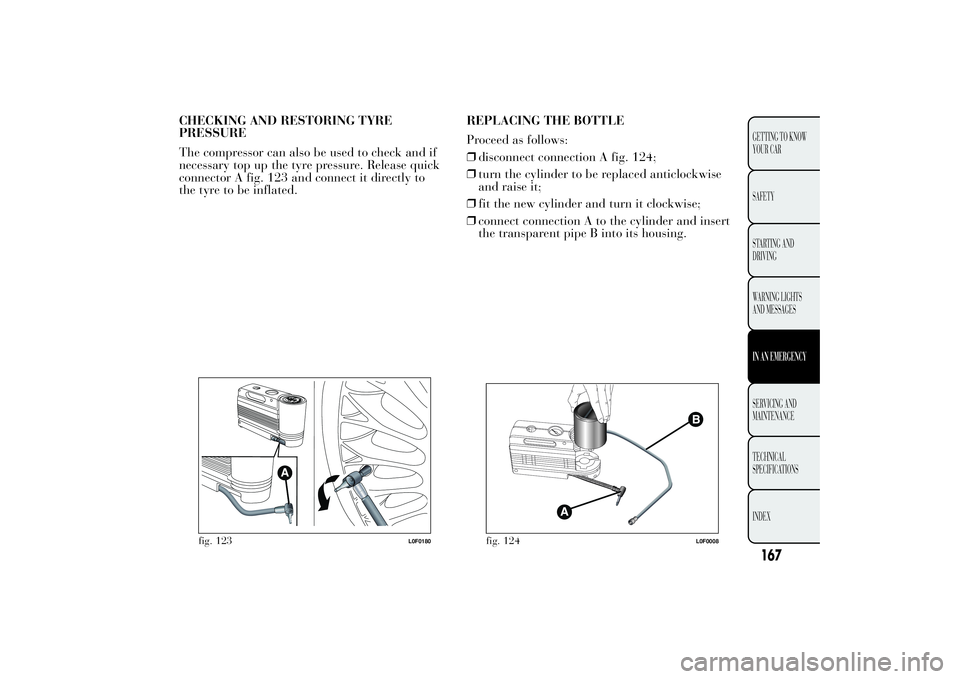
CHECKING AND RESTORING TYRE
PRESSURE
The compressor can also be used to check and if
necessary top up the tyre pressure. Release quick
connector A fig. 123 and connect it directly to
the tyre to be inflated.REPLACING THE BOTTLE
Proceed as follows:
❒disconnect connection A fig. 124;
❒turn the cylinder to be replaced anticlockwise
and raise it;
❒fit the new cylinder and turn it clockwise;
❒connect connection A to the cylinder and insert
the transparent pipe B into its housing.
fig. 123
L0F0180
fig. 124
L0F0008
167GETTING TO KNOW
YOUR CAR
SAFETY
STARTING AND
DRIVING
WARNING LIGHTS
AND MESSAGESIN AN EMERGENCYSERVICING AND
MAINTENANCE
TECHNICAL
SPECIFICA
TIONS
INDEX
Page 172 of 299
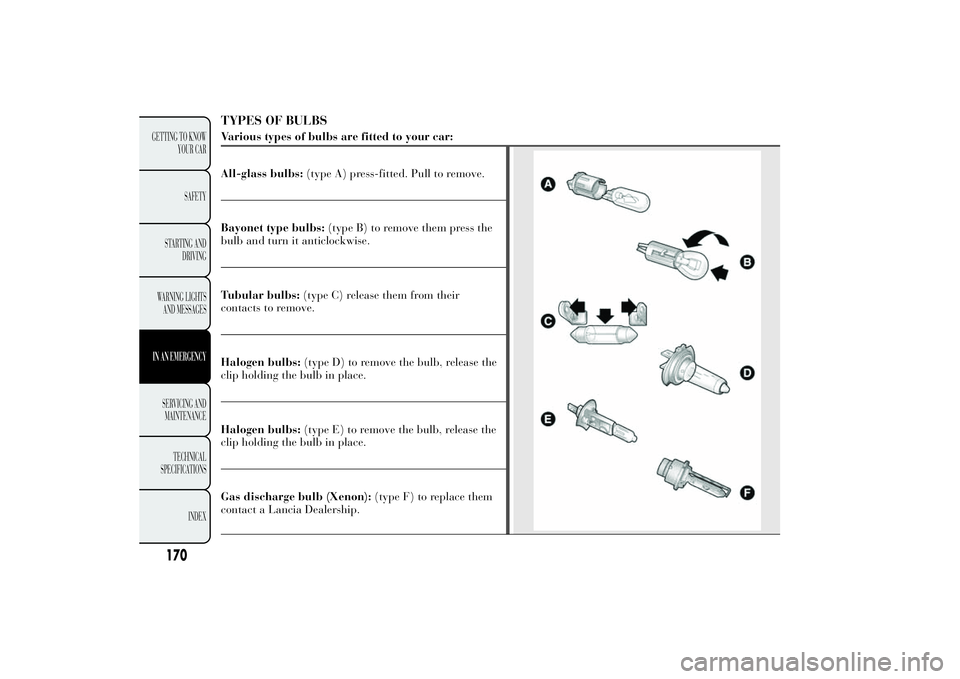
TYPES OF BULBSVarious types of bulbs are fitted to your car:
All-glass bulbs:(type A) press-fitted. Pull to remove.Bayonet type bulbs:(type B) to remove them press the
bulb and turn it anticlockwise.
Tubular bulbs:(type C) release them from their
contacts to remove.
Halogen bulbs:(type D) to remove the bulb, release the
clip holding the bulb in place.
Halogen bulbs:(type E) to remove the bulb, release the
clip holding the bulb in place.
Gas discharge bulb (Xenon):(type F) to replace them
contact a Lancia Dealership.
170
GETTING TO KNOW
YOUR CAR
SAFETY
STARTING AND
DRIVING
WARNING LIGHTS
AND MESSAGESIN AN EMERGENCYSERVICING AND
MAINTENANCE
TECHNICAL
SPECIFICA
TIONS
INDEX
Page 175 of 299
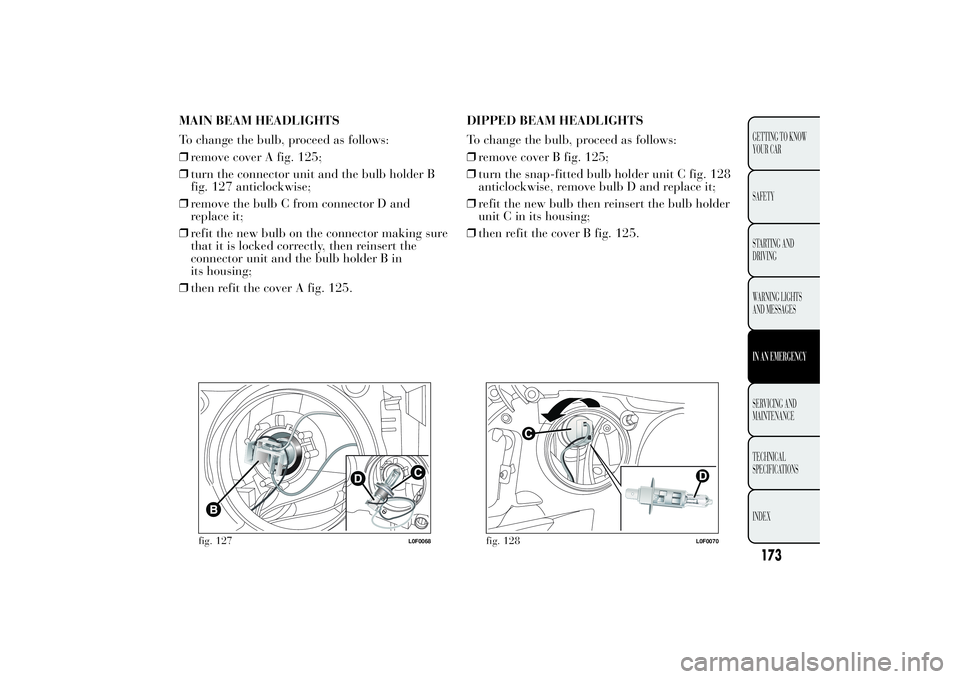
MAIN BEAM HEADLIGHTS
To change the bulb, proceed as follows:
❒remove cover A fig. 125;
❒turn the connector unit and the bulb holder B
fig. 127 anticlockwise;
❒remove the bulb C from connector D and
replace it;
❒refit the new bulb on the connector making sure
that it is locked correctly, then reinsert the
connector unit and the bulb holder B in
its housing;
❒then refit the cover A fig. 125.DIPPED BEAM HEADLIGHTS
To change the bulb, proceed as follows:
❒remove cover B fig. 125;
❒turn the snap-fitted bulb holder unit C fig. 128
anticlockwise, remove bulb D and replace it;
❒refit the new bulb then reinsert the bulb holder
unit C in its housing;
❒then refit the cover B fig. 125.
fig. 127
L0F0068
fig. 128
L0F0070
173GETTING TO KNOW
YOUR CAR
SAFETY
STARTING AND
DRIVING
WARNING LIGHTS
AND MESSAGESIN AN EMERGENCYSERVICING AND
MAINTENANCE
TECHNICAL
SPECIFICA
TIONS
INDEX
Page 176 of 299
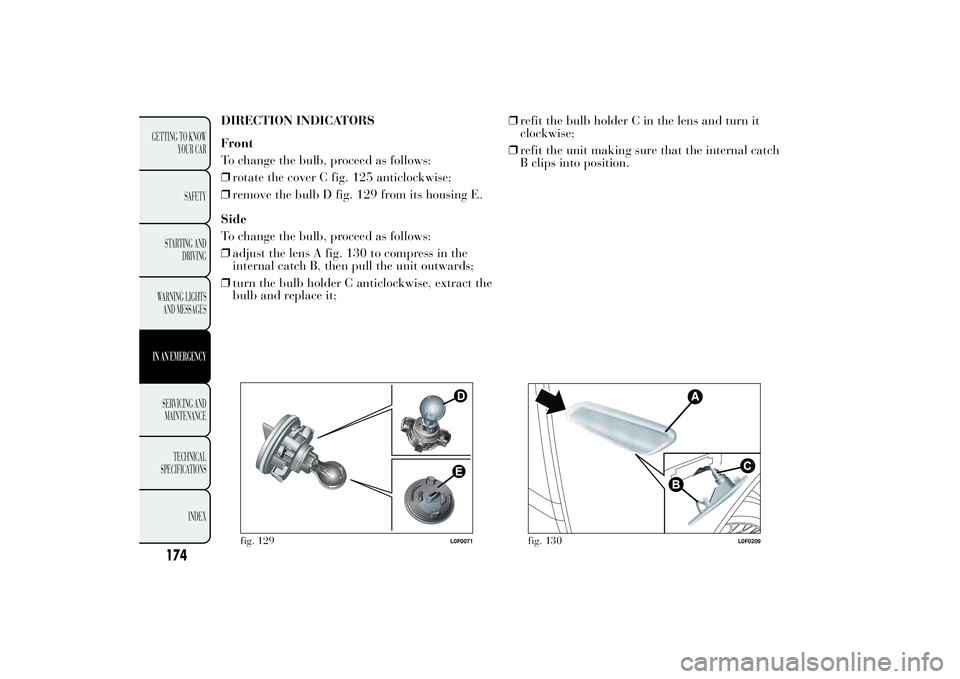
DIRECTION INDICATORS
Front
To change the bulb, proceed as follows:
❒rotate the cover C fig. 125 anticlockwise;
❒remove the bulb D fig. 129 from its housing E.
Side
To change the bulb, proceed as follows:
❒adjust the lens A fig. 130 to compress in the
internal catch B, then pull the unit outwards;
❒turn the bulb holder C anticlockwise, extract the
bulb and replace it;❒refit the bulb holder C in the lens and turn it
clockwise;
❒refit the unit making sure that the internal catch
B clips into position.
fig. 129
L0F0071
fig. 130
L0F0209
174
GETTING TO KNOW
YOUR CAR
SAFETY
STARTING AND
DRIVING
WARNING LIGHTS
AND MESSAGESIN AN EMERGENCYSERVICING AND
MAINTENANCE
TECHNICAL
SPECIFICA
TIONS
INDEX
Page 177 of 299
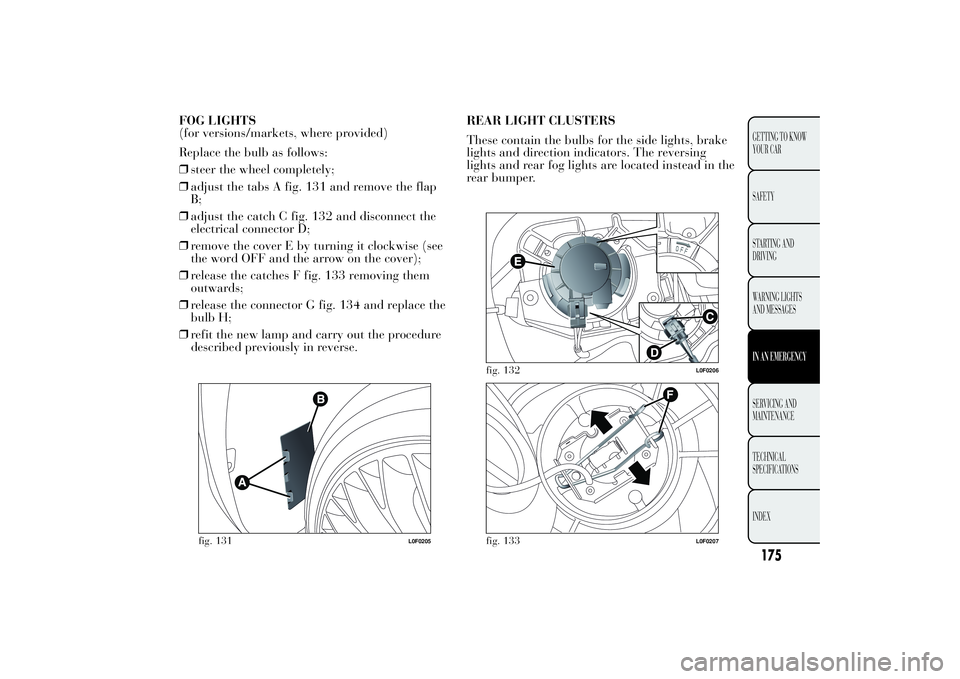
FOG LIGHTS
(for versions/markets, where provided)
Replace the bulb as follows:
❒steer the wheel completely;
❒adjust the tabs A fig. 131 and remove the flap
B;
❒adjust the catch C fig. 132 and disconnect the
electrical connector D;
❒remove the cover E by turning it clockwise (see
the word OFF and the arrow on the cover);
❒release the catches F fig. 133 removing them
outwards;
❒release the connector G fig. 134 and replace the
bulb H;
❒refit the new lamp and carry out the procedure
described previously in reverse.REAR LIGHT CLUSTERS
These contain the bulbs for the side lights, brake
lights and direction indicators. The reversing
lights and rear fog lights are located instead in the
rear bumper.
fig. 131
L0F0205
fig. 132
L0F0206
fig. 133
L0F0207
175GETTING TO KNOW
YOUR CAR
SAFETY
STARTING AND
DRIVING
WARNING LIGHTS
AND MESSAGESIN AN EMERGENCYSERVICING AND
MAINTENANCE
TECHNICAL
SPECIFICA
TIONS
INDEX
Page 180 of 299
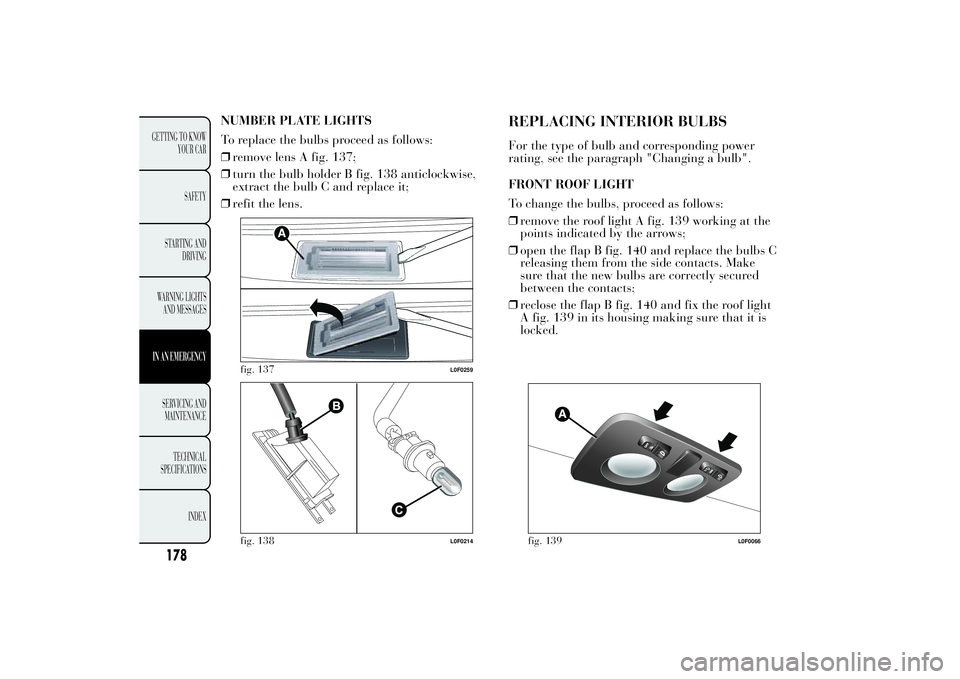
NUMBER PLATE LIGHTS
To replace the bulbs proceed as follows:
❒remove lens A fig. 137;
❒turn the bulb holder B fig. 138 anticlockwise,
extract the bulb C and replace it;
❒refit the lens.
REPLACING INTERIOR BULBSFor the type of bulb and corresponding power
rating, see the paragraph "Changing a bulb".
FRONT ROOF LIGHT
To change the bulbs, proceed as follows:
❒remove the roof light A fig. 139 working at the
points indicated by the arrows;
❒open the flap B fig. 140 and replace the bulbs C
releasing them from the side contacts. Make
sure that the new bulbs are correctly secured
between the contacts;
❒reclose the flap B fig. 140 and fix the roof light
A fig. 139 in its housing making sure that it is
locked.
fig. 137
L0F0259
fig. 138
L0F0214
fig. 139
L0F0066
178
GETTING TO KNOW
YOUR CAR
SAFETY
STARTING AND
DRIVING
WARNING LIGHTS
AND MESSAGESIN AN EMERGENCYSERVICING AND
MAINTENANCE
TECHNICAL
SPECIFICA
TIONS
INDEX